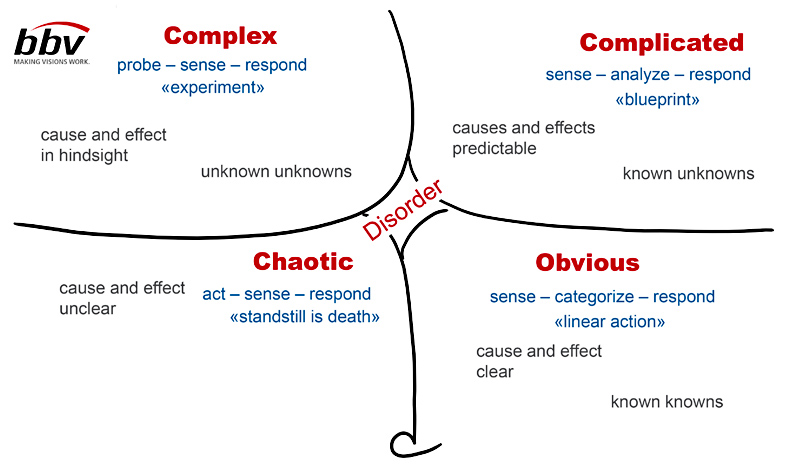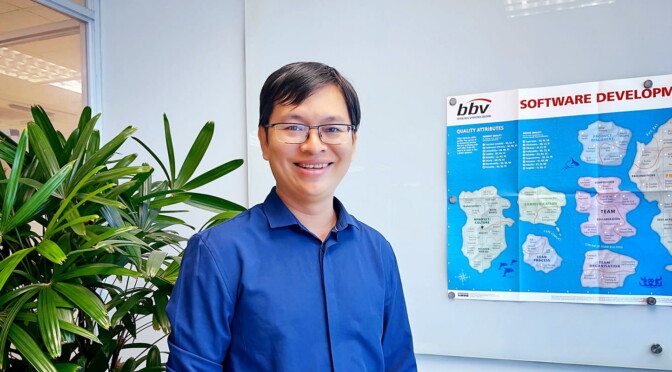When dirt gets the upper hand in your home, you inevitably reach for a cloth, mop and duster to whip it back into shape. It makes sense. Just a little effort and your home shines again in new splendour. Simple problem, simple solution, it would appear. But what if there are suddenly no more cleaning products in your cupboard or the vacuum cleaner goes on strike? It doesn’t help that the shops are already closed and your guests are due to arrive in a few hours. Very quickly, a simple problem turns into something complicated. Or even complex?
One thing is certain: Not all problems are the same – and depending on the situation, certain solutions are more appropriate than others. However, it is not always easy to accurately assess the extent of a problem or situation. This is precisely where the Cynefin framework comes into play: Developed by Welsh researcher and knowledge management consultant David Snowden, Cynefin makes it easier to assess different situations and find appropriate solutions.

Assessing problems accurately with Cynefin
The framework essentially consists of a grid with five domains. These help with problem analysis and are intended to give the user clues as to the complexity of their problem. In addition, Cynefin records typical procedures for individual domains, which can be used to tackle the corresponding problem. The five domains:
Disorder: It is not yet clear what kind of problem you are facing. The person concerned has not yet thought about the extent of their problem and its individual aspects. Tasks and problems are classified here if we do not know enough about them as yet to be able to assign them to another category. According to Snowden, this is usually the category we find ourselves in: We do not consciously know what system type we are dealing with – or we still lack a general understanding of these differences. Further investigations should make it easier to understand situations and problems and to be able to assign them to a different domain.
Obvious: The “Obvious” domain belongs to the “ordered” category: Problems and situations in this category have clearly defined cause-and-effect relationships and patterns that are familiar to everyone. Snowden therefore also refers here to “known knowns” and lists the steps “sense, categorise, response” as the recommended course of action: A problem is identified, categorised and assessed and responded to appropriately – in other words, following a predefined procedure.
- Example: Administration processes, among others, are typical examples of the “Obvious” domain. For instance, late payment of rent. The approach here is always the same: If the landlord does not receive the rent, they send (as a first step) a reminder to the tenant.
- Typical aids: Checklists, simple flowcharts, if-then statements.
Complicated: The “Complicated” domain also belongs to the “ordered” category: however, cause and effect are no longer obvious and depend on various known variables – which is why Snowden refers here to “known unknowns”. A certain degree of expert knowledge is needed to solve the problem and determine the cause and effect. The recommended course of action for this domain is to “sense-analyse-respond”: The cause of a problem can be determined with close observation and analysis.
- Example: Machines are typical examples of complicated systems. Recognising that there is a problem is simple; however, expert analysis is needed to resolve the problem.
- Typical aids: More complicated flowcharts, tables and matrices.
Complex: Cause and effect cannot be fully ascertained in advance. At best, relationships can be identified afterwards. Individual factors can no longer be determined because they change constantly and interact with each other in different ways – which is why this domain involves “unknown unknowns”. The only approach therefore is to “probe-sense-respond” – in other words experiment. I hypothesise, try things, identify the methodology and the effect and respond accordingly.
- Example: Human interactions of any type are characteristic of this system type.
- Typical aids: We need adaptable methods rather than simple tools for complex systems. You need to be able to abandon the idea of being able to plan and be open to not knowing. A non-judgemental attitude is also fundamental here in order to be able to perceive emerging solutions (emergent practice).
Chaotic: We cannot determine the relationship between cause and effect. Experimentation or analysis is a waste of time here, action is needed – “act, sense, respond” is the motto. It is only by establishing a certain order that the situation can be moved from chaos to other domains.
- Example: Typically chaotic states include crises, natural disasters or emergency situations. In a business context, this type can perhaps be identified prior to bankruptcy or during a stock market crash.
- Typical aids: Behavioural norms (standard operation practices) are needed here as opposed to tools and methods. Quick action is required in order to stabilise existing systems again. The effect of the action is then apprehended in order to react or act again.
Cynefin is a sense-making framework
What is important with Cynefin is that the boundaries between the individual domains are by no means rigid, but depend on the observer and their level of knowledge. The user’s expertise can therefore decide whether a problem is regarded as “Complex” or – since it has had to be dealt with many times already – as “Complicated”. The Cynefin framework is therefore less used for fixed categorisation of problems and also not for solving these problems substantively. Cynefin should do one thing above all: bring sense. It provides guidance for users and acts as a basis for mutual understanding.
Cynefin also shows that problem-solving strategies can be successful in one domain, while being ineffective or even counter-productive in another domain. In some cases, the framework may also be able to explain why you simply cannot make any progress in finding a solution. After all, people are creatures of habit – and often fixated in their actions on a few approaches that worked in the past. Thanks to Cynefin, existing and preferred solutions can be re-evaluated and questioned. The framework therefore ultimately helps to significantly improve room for manoeuvre when dealing with new situations and problems.

The expert
Dominik Berner
Dominik Berner is a Software Engineer at bbv. Thanks to his know-how in the MedTech field, he knows the growth limits of start-ups and small companies, but also the conditions in large companies. As an agilist, Berner regards software development as a team sport that requires a strong corporate culture.







